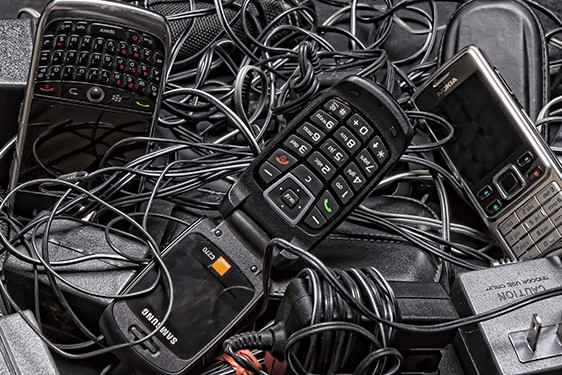
How to find a better final resting place for your cell phone and reduce your footprint.
Hollywood often glorifies cell phone disposal – spies and agents ditch their used cell phones in the closest garbage can to avoid being traced, tracked or made. In reality those agents should be recycling their e-waste.
Electronic waste, or e-waste, is a growing problem as consumers race to catch up to evolving technology by buying the newest smart phone, slimmest laptop or fastest tablet. In 2010, Statistics Canada reported citizens of Ontario own 42 per cent, or 10,832,130, of the mobile phones in use in Canada. Canadians greatly contribute to the estimated 50 million tonnes of e-waste that are disposed of each year worldwide (which to put it in perspective is the equivalent to 50,000 LCD televisions or 3,250,000 laptop computers).
The City of Toronto tries to prevent e-waste from entering landfills by offering a free e-waste recycling program to residents living in houses, apartments and condominiums. Not only does the city offer curbside collection for houses (if left out on designated garbage days); there are also drop-off depots available. In addition to cell phones, other electronics can be recycled, including computer cables and accessories, laptop and desktop computers, cameras and televisions. Check with your city’s government website to discover the e-waste recycling options in your city.
While the government urges consumers to drop off old cell phones at an e-waste disposal depot where all the parts of the phone can be dealt with, City of Toronto Director of Processing and Resource Management for Solid Waste Management Services Derek Angove says that they urge consumers to recycle when possible because landfill space is valuable, and believes it should be saved for waste that can’t be reused.
Since all manner of e-waste contains valuable materials such as gold, silver and platinum, as well as base metals like steel, iron, zinc and copper, these parts are often taken apart and repurposed into new products. E-waste is also a good source of glass and plastics. More than 90 per cent of e-waste’s component parts can be recycled. Fourteen tonnes of electronic waste creates one tonne of copper, which would otherwise have to be mined underground. That copper is enough to make 5,000 new cell phones!
The Ontario Electronic Stewardship is a non-profit organization that works to divert electronics from landfills and encourage more responsible behavior in consumers. It was developed in partnership with Waste Diversion Ontario on behalf of the Ontario government under the Waste Diversion Act 2002. Since the program began in April 2009, the Ontario Electronic Stewardship has diverted over 250,000 tones of e-waste from landfills, and that number just keeps growing.
After cell phones are collected or dropped off at an e-waste drop off location, they, along with other discarded electronics, are shipped to a facility where they are inspected and weighed. They are then manually dismantled or mechanically processed by an approved processor. Hazardous materials are separated and sent for further processing, while materials that can be down-cycled into steel, aluminum, copper, glass or plastic are made ready to be used in new products.
Before you Discard your Cell phone
When recycling your phone, ensure you separate your phone’s battery from the handset. “We have separate battery recycling as well, so you can put the phone out for recycling. The battery, however, is different. We recycle batteries at our depots, but you want to bring those in separately. You wear out your battery sometimes more frequently than your phones, so we take just the battery as well for convenience,” says Angove.
Phones for Food
Another way for consumers to recycle old cell phones is the Phones for Food program, sponsored by Rogers Communications, Sony Canada, Purolator and Global Electric Electronic Processing. This industry-leading phone-recycling program focuses on diverting waste from landfills while raising money for Food Banks Canada. They do this by recycling used cell phones and accessories and using the profits for charity. Since its inception in 2003, as the first national wireless device recycling program in Canada, Phones for Food has recycled over 750,000 cell phones.
Consumers can participate by dropping off their old phones and accessories at over 1,000 Rogers Plus, Rogers Wireless and Fido locations across most of Canada’s major cities. The company also offers a postage-paid recycling envelope with most new wireless device purchases, so users can send in old devices to be recycled or refurbished at any time.
Phones for Food has raised over $750,000 to support the food banking community, and was awarded the Connected to the Community award by the Canadian Wireless Telecommunications Association in 2010.
Clean Before you Toss
“It’s important to remember that you’re throwing away not just cell phones but Blackberries and iPhones, and those are different generations,” says Angove. “The information that you have on there can be taken off and used illegally so you have to make sure you really clear the information from your cell phone or your electronic devices before you throw them out because they’re going to pass through many people’s hands and you want to be very careful with your personal information.”
What many people don’t realize is that at the time of purchase for most electronics, retailers charge an environmental handling fee (EHF), which is put in place to cover the cost of refurbishing or recycling these products at the end of their life. The cost includes the collection, transportation and processing of e-waste, as well as research and educational programs promoting the responsible management of electronic waste. Unfortunately less than 40 per cent of Ontario residents recycle their old electronics, while over 90 per cent of Ontario residents are holding on to old electronics that they will never use again, but do not recycle. Don’t let that money go to waste by ditching your cell phone in the closest garbage can.
Help the environment by recycling your old cell phone. Reducing your carbon footprint will feel great – and who knows, maybe the Hollywood spies will catch on, too. VM













